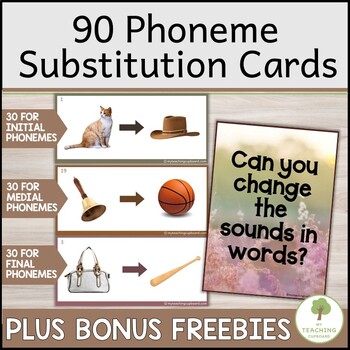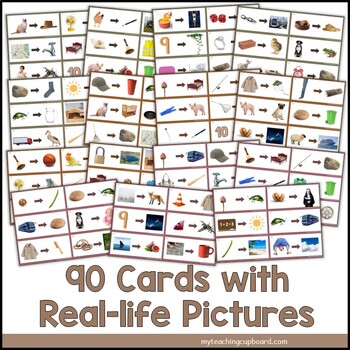Phoneme Substitution Cards for Change the Sound Phoneme Manipulation Activities
- PDF
Description
These Phoneme Substitution Cards are for students learning to change the sound in words. Designed to build essential phonemic awareness skills, they are the perfect tool for phoneme manipulation activities teaching children how to substitute initial, medial, and final sounds to create new words.
This comprehensive set contains 90 phoneme substitution task cards:
• 30 Beginning Sound Cards
• 30 Medial (middle) Sound Cards
• 30 Ending Sound Cards
The cards are colour-coded and illustrated with real-life pictures, so your students will easily recognise and relate to the pictures.
PLUS, there are BONUS resources in this pack.
CHECK OUT THE PREVIEW TO SEE ALL THE EXTRAS
Keep Students Engaged
These cards keep students actively engaged in hands-on activities that are simple yet effective. With these Phoneme Substitution Cards, you'll engage your students with a fun and interactive phoneme manipulation activity.
By learning to substitute sounds, your students will develop a deeper understanding of how to manipulate the sounds in words. This important skill lays the foundation for strong reading and writing skills.
Build Phonemic Awareness
Phoneme manipulation is an important phonemic awareness skill. It involves changing the individual phonemes or speech sounds in a word in order to create a new word.
It involves adding, deleting and substituting the sounds in words.
This skill is considered one of the more challenging aspects of phonemic awareness so students need lots of practice. That’s why I designed this set of Phoneme Substitution Cards. They are a practical and hands-on way for students to practice deleting a sound from a word and then changing it with a new sound to make new word!
The Science of Reading research explains phonemic awareness as an oral and auditory skill so these cards contain only pictures—no written words.
This Phoneme Substitution Resource Contains:
- 30 cards for initial sound substitution
- 30 cards for medial sound substitution
- 30 cards for final sound substitution
- Answer key
- 4 Printable learning prompts
- 4 printable recording sheets
No more trying to think up suitable words on the spot or trying to source suitable images.
Download this set of 90 phoneme manipulation cards, and you’ll have plenty to choose from right at your fingertips.
Perfect for:
- hands-on literacy investigation areas
- literacy centers
- small group literacy rotations
- literacy intervention
- morning tubs
- busy bags
- early finishers
- homework
- or for informing your assessment grades
2 Ways to Use These Phoneme Substitution Cards
- Orally in small groups: Use the cards to say the words with the students. Ask them what sound changed in the word: beginning, middle or ending sound?
- Hands-On Independent Practice: Use the cards in literacy centers or investigation areas. To build phonemic awareness, students manipulate the sounds orally using the pictures. More advanced students can progress to writing the new word or making it with letter tiles.
Check out the preview to sneak a peek at all the ways I use these resources in my classroom.
This resource supports the following standards:
CCSSRF.K.2
Demonstrate understanding of spoken words, syllables, and sounds (phonemes).
CCSSRF.K.2d
Isolate and pronounce the initial, medial vowel, and final sounds (phonemes) in three-phoneme (consonant-vowel-consonant, or CVC) words. (This does not include CVCs ending with /l/, /r/, or /x/.)
CCSSRF.K.2e
Add or substitute individual sounds (phonemes) in simple, one-syllable words to make new words.
CCSSRF.1.2
Demonstrate understanding of spoken words, syllables, and sounds (phonemes).
RF.1.2c
Isolate and pronounce initial, medial vowel, and final sounds (phonemes) in spoken single-syllable words.
Don't forget to FOLLOW MY STORE to be notified about product updates and new play-based learning resources.
Stay in touch with My Teaching Cupboard
And HERE on my blog





